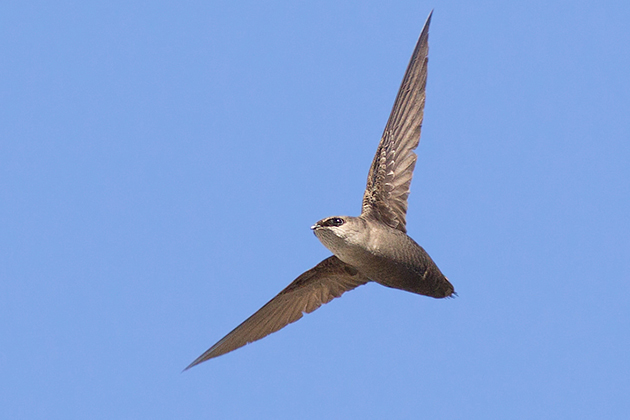
At sunset on Monday, a crowd of about 50 spectators gathered on Main Street in downtown Willimantic. Led by UConn faculty member Margaret Rubega, the Connecticut State Ornithologist, the group was there to witness a chimney swift “tornado,” or swarm, as the birds returned to their chimney homes for the night.
“We’ve identified roosts of up to 900 birds” in the Nathan Hale Building and Windham Town Hall, Rubega told the group.
The gathering was part of Chimney Swift Conservation Night at the Willimantic Brewing Co. and Main Street Café, where local birders, conservation enthusiasts, and members of the community drank a special microbrew in honor of the birds, learned about their habits and conservation, and watched for themselves as the swifts flew in circles right above their heads.

The event highlighted Willimantic as an important urban habitat for the species, which Rubega describes as a small, brown, unmelodic bird that glues its nests together with spit. The birds’ feet are modified so they can’t perch on horizontal surfaces, so they nest in vertical, dark spaces like chimneys.
Chimney swifts are one of several species of avian insectivores – birds that feed on insects – that are experiencing population decline. The chimney swift population, which can be found east of the Rocky Mountains and from Canada all the way down the Eastern seaboard, has been in decline over the past 40 years, though it has been relatively stable in the geographical region that includes Connecticut.
“The stability could mean that we’re a sink, meaning that birds come here and disappear and new birds come in behind them,” said Rubega, an associate professor of ecology and evolutionary biology who has become a vocal advocate for the birds. “It also could mean that we have a great environment for chimney swifts, in which case it is important to find and preserve characteristics that encourage stability.”
In this spirit of advocacy, Rubega and colleague Min Huang, who leads the migratory gamebird program at the Connecticut Department of Energy and Environmental Protection (DEEP), approached Willimantic Brewing Co. owner and brewer David Wollner to host the event.

Wollner concocted a special beer, dubbed Flying Cigar Ale, named for the body description frequently used by birders to identify chimney swifts. A portion of the beer’s profits will go to chimney swift conservation efforts.
“People love to come downtown, and we’re spreading the news about the birds,” Wollner said. “It’s just all-around good for the community.”
Huang noted that he is invested in the birds both professionally and personally as a resident of Willimantic. “I love to see people coming to downtown Willimantic, especially to see the nature that’s in their own hometown,” he said.
Rubega became aware of chimney swifts while researching the feeding mechanics of hummingbirds. Her questions about common ancestors led her to the existing literature on chimney swifts.
“I emerged thinking, ‘We don’t know much about these birds and they appear to be in trouble … somebody needs to look into this,’” she said.
The biology of chimney swifts makes them difficult to study. In addition to nesting in dark, secluded locations, they fly relatively quickly – up to 35 miles per hour – and at high altitudes. The swifts also spend the majority of their year in migration to South America, but scientists so far have been unable to pinpoint exactly where the birds reside on the southern continent.
In 2006, Rubega began working with DEEP avian biologist Shannon Kearney-McGee, resulting in “a fruitful partnership” between UConn and the state agency.
“They have a mandate to preserve wildlife and are empowered to take actions in ways that I am not able to, but they do not always have the time to pursue research that would inform what actions will produce the best outcomes,” said Rubega. “That’s where we step in.”
Since then, the ornithologist and her DEEP colleagues have studied the natural characteristics of geographic areas that attract chimney swifts. Their findings identified a large population of chimney swifts in Willimantic.
The birds are attracted to the city’s historic buildings with uncapped chimneys made of rough materials like brick, says Rubega. They are also attracted to some characteristics of the surrounding natural landscape, but the scientists are still figuring out what those factors are. By monitoring roosts in the area and trying to locate new nests, Rubega’s team is trying to track population patterns and pinpoint favorable environmental factors.
Rubega hopes to use this opportunity to promote an appreciation among Willimantic residents for the wildlife resource in their town, as evidenced by the inaugural conservation night event.
“People turn on the TV and they watch Animal Planet,” she said. “That tends to encourage a mentality that nature and wildlife is somewhere else. But it’s not, it’s right in the middle of your town! All you have to do is step out on the sidewalk and look up.”
The Flying Cigar Ale will continue to be sold at the brewery throughout July or until supplies run out.



